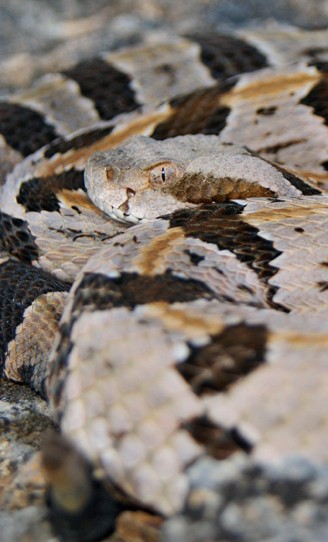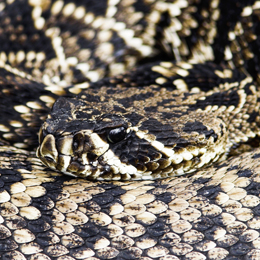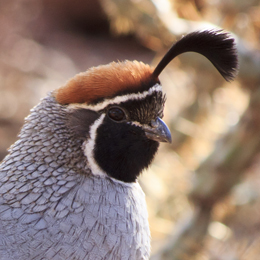Physical Description
The Timber rattlesnake is a deadly reptile, another offspring of the pit viper family that commonly inhabits regions of the United States and Canada. It is quite unwise to consider this snake harmless because it can raise a mighty fight if it feels threatened.
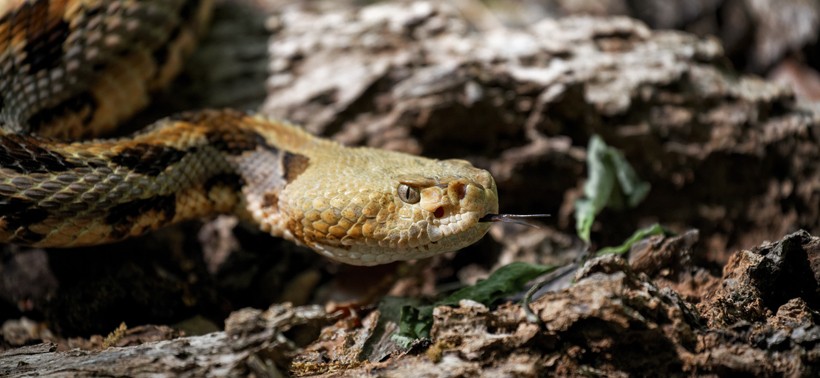
The heavy, large sized timber rattlesnake is mostly found in the eastern parts of the United States
?
Image credits: Norm Legault/Shutterstock
Their heavy, large sized body and dark coloring help to ambush prey in the dark. The primary background color of the Timber rattlesnake is light brown or yellowish brown that consists of black cross bands that are irregularly placed all over.
A distinguishable feature of the Timber rattlesnake is the presence of rust-colored vertebral stripes that can also be yellow or black in color.
There is considerable debate over the northern (C.h.horridus) and the southern Timber rattlesnake (C.h.atricaudatus) as to whether the two can be considered subspecies. At the moment, both the northern and the southern Timber rattlesnakes have been considered as being the same variant.
Habitat
Found commonly in woodland extensions, the Timber rattlesnake inhabits the deciduous forests of eastern United States. This species can occur in a range of distinct habitats right from river floodplains to cane thickets in the lowlands.
In the north, the rattlesnake inhabits mountainous terrains where rocky hills or stony crevices make excellent hibernating dens. In the southern parts of the distribution, the snake inhabits marshy or swampy thickets.
In the Midwest particularly Timbers forage widely in mature forests that inhabit rocky slopes or riparian areas.
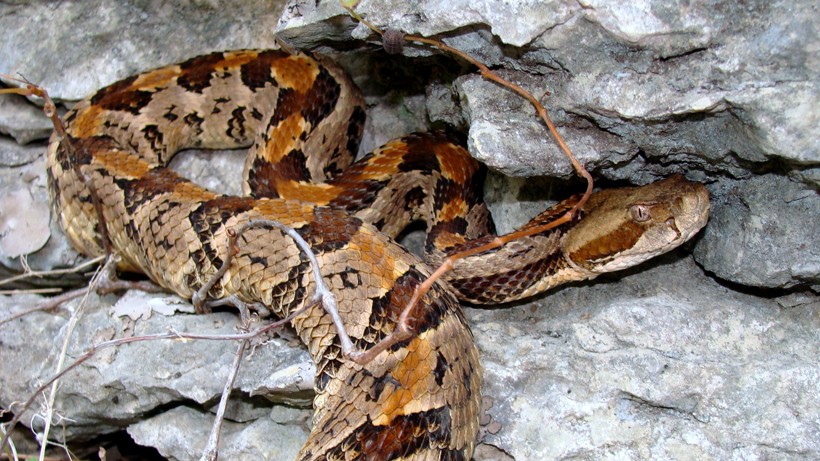
Crawling on limestone bluff in the forest of Missouri
?
Image credits: Matt Jeppson/Shutterstock
During the summer months, a pregnant female tends to occupy open hilly terrains whereas males and non-gravid females prefer the cooler suburbs of a closed forested canopy. Though the Timber rattlesnake is mostly nocturnal it can still remain active during the daytime, generally in the late spring season.
During the colder months, the snakes tend to hibernate or brumate which is a form of dormancy that is triggered by the lack of heat in the environment.
The south-central part of Indiana consists of Timber rattlesnakes that occupy oak wood forests since exposed rocks are a scarcity in the region.
Basic Anatomy
Weighing around 1 – 2.5 kg, this species showcases sexual dimorphism where the males are larger in size than females. While the males generally carry a weight of 2 – 2.5 kg, the females are lighter and smaller with an approximate weight of 1.3 – 1.5 kg.
The species presents a light and dark stage, both a distinct representation of the rattlesnake’s unique coloring. Commonly a Timber rattlesnake that showcases a dark-grey background maintains rich black velvety patterns. But for a species that consists of a yellow tan, the patterns generally are in the form of dark yellow or brown tinged patches.
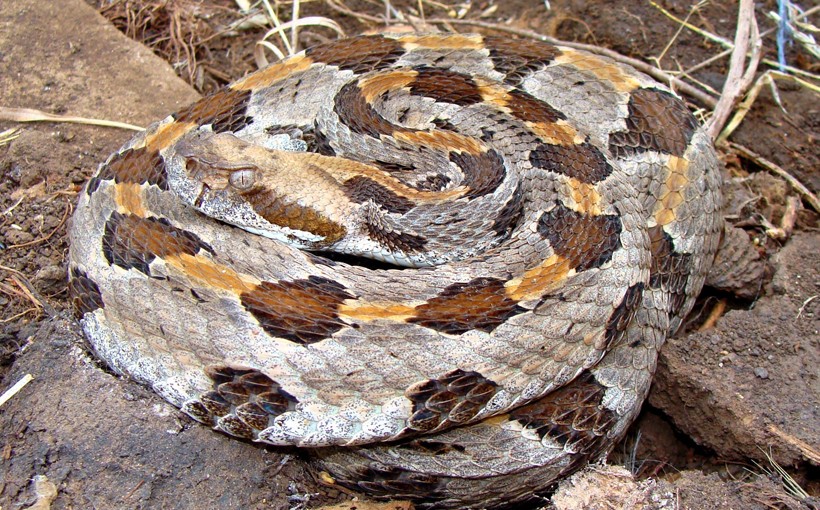
The body of the rattlesnake consists of 25 dorsal scales
?
Image credits: Matt Jeppson/Shutterstock
The mid body of a Timber rattler consists of 25 dorsal scales aligned into keeled rows. While males have 20-30 subcaudal scales, females generally showcase a varied number of 15 – 26 subcaudal scales.
A rugged terrain is an ideal habitat for Timber rattlesnakes that maintain an approximate size of 3 – 5 ft in length, with a flattened, broad triangular shaped head.
As all rattlesnakes, this species also retains horny segments of the integument that form the rattle, maintaining a standard black coloring.
Geographical Distribution
According to past research, the historical distribution of the Timber rattlesnake was found to be mostly in eastern parts of the United States.
The reptile can be found in southern Minnesota, with a distribution range that extends till southern New Hampshire and north of Florida.
In Canada, the species inhabits parts of southern Ontario and Quebec however habitat destruction has decreased the population greatly. Because of this, it has been listed as threatened according to the Species at Risk Act.

Timber rattlesnake, Elk State Forest, Pennsylvania
?
Image credits: Paul Staniszewski/Shutterstock
The species dwells mostly in southeastern Iowa, within the thick forests of the Des Moines valley and along the shores of the Mississippi River. While the northern boundary of the snake covers southeast Minnesota and southern Maine, the southern boundary extends till the central parts of Texas, including northern Florida.
A lot of mixed forested habitats that enclose a number of rocky crevices, bushy logs and remote swamps offer ideal sites for hibernation.
Diet
The diet of Timber rattlesnakes varies geographically depending upon the kind mammalian prey available. The Timber rattlesnake feeds on terrestrial vertebrates, the main food source being small rodents like mice, shrew, squirrels, voles etc.
Birds can also fall prey to this incredible species that particularly feeds on Peromyscus.
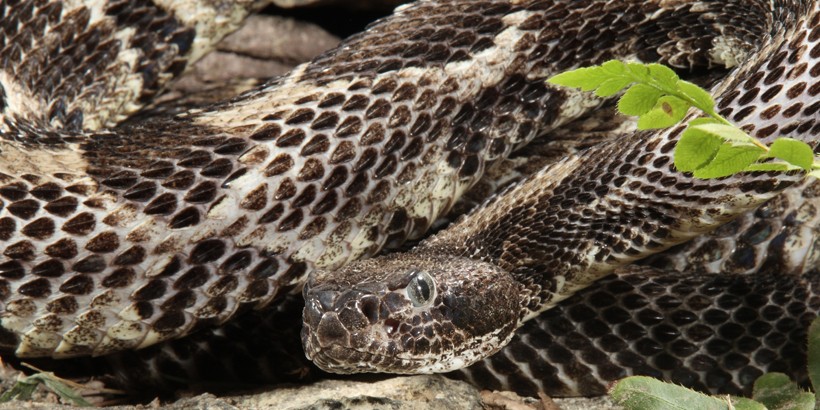
This heavy, large rattlesnake feeds mainly on small mammals
?
Image credits: Dennis W. Donohue/Shutterstock
While baby rattlers find it hard to attack adult bobwhites and cottontail rabbits, they can easily catch a smaller sized prey like frogs, mice and shrews. Grey squirrels, chipmunks, weasels and rabbits are commonly part of its food diet, but it can also consume small birds like baby ducks, baby turkey, grouse, sparrows, wrens etc.
Prey
A common observation made in the case of the Timber rattlesnake is that it spends most of its time lurking in the shadows, waiting for a defenseless food source.
It is one of North America’s most lethal snakes with an impressive venom yield and long, sharp fangs. The venom of this snake is neurotoxic and contains active peptides that release a fibrinogen clotting enzyme that paralyzes the prey.
The rattle is used mainly to ward off predators however it can also be used as bait while the snake readies itself for a secretive ambush.
Sensitive to temperature fluctuations, the rattlesnake consists of a series of pits or sensory organs that can pick up heat radiations from the surroundings. This ability helps the snake to hunt during the dark, alternatively, it picks vibrations by flicking its tongue. The air-borne particles are sent through the jaw bone of the snake and into the Jacobson’s organ that instinctively conveys the distance at which the prey is located.
The presence of such excellent sensory models help the snake ward off predators especially when it understands the approaching species is larger than its own size.

Timber ready to strike, Northeastern United States
?
Image credits: Joe McDonald/Shutterstock
The Timber rattlesnake often hides behind rocks or leaf litter before it swoops down to catch its prey after which it injects a lethal dose of venom. Once the prey becomes paralyzed and is unable to move, the snake devours its vulnerable catch and swallowing it whole.
In order to digest its prey faster, the Timber rattlesnake must raise its body temperature as high as 27 - 30 degree Celcius (80 to 85 degree Fahrenheit).
This species always determines the size and distance of the prey before it decides to position itself at a particular point for an unexpected ambush.
Typically Timber rattlesnakes position themselves on a fallen log, lying motionless with their heads resting perpendicular to the log.
Their heat sensory pits allow them to pick up vibrations on the log, detecting their prey visually. They usually await a prey’s arrival on the side of a mammal trail, striking it in a single swift movement.
Timbers then follow the dying animal’s scent trail, consuming it whole and digesting it with the help of certain enzymes in its stomach that helps break down the ingested prey’s bones.
Predator
The Timber rattlesnake is as much part of the food chain as its prey, so it does possess a few predators that it cannot evade in the wild.
Commonly known animals that hunt down a Timber rattlesnake include coyotes, feral cats, prairie dogs, King snakes, Black adders, hawks, owls, raccoons, foxes and opossums.
Humans are the most dangerous predators of the Timber rattlesnake that often becomes a game for seasonal activities like illegal hunting.
Behavior
Timber rattlesnakes live a solitary life, engaging with one another mainly during the breeding season. A unique trait of the rattlesnake is its ability to adjust to a number of distinct habitats depending upon the temperature.
During the warm months, late spring or early summers the snakes migrate towards a forest cover, preferably woodlands traveling far and away from their winter dens.
Since they cannot tolerate the winter season, they hibernate or brumate alongside other canebrakes to avoid the drop in temperature.
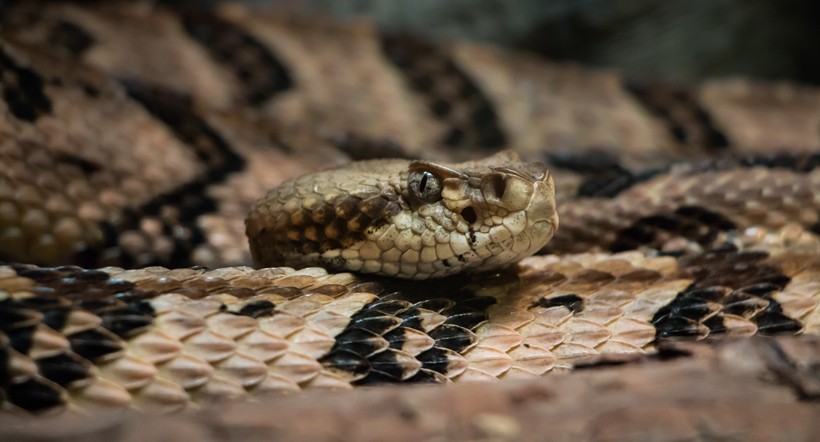
The period of hibernation lasts for about 7-8 months
?
Image credits: Dennis Riabchenko/Shutterstock
While hunting for a den, these snakes are very picky and often return to the same den the following winter. The period of hibernation lasts for about 7-8 months usually occupying rocky crevices on hilly terrains.
A den can occupy around 15-16 snakes surprisingly and is definitely not a friendly place to stumble into if you’re out in the woods.
Limestone crevices are also comfortable dens for most copperheads, black rat snakes and timber rattlesnakes where they congregate during the cold winter months.
Though bites are not common in the United States, the Timber rattlesnake is considered one of the most venomous snakes of the North American continent.
Reproduction Cycle
One of the most interesting characteristics of the Timber rattlesnake is its ability to woe its mate during the breeding season.
Males often fight over a receptive female and try to overshadow this competition by engaging in a wrestling match. Males often follow scent trails that are formed as a result of pheromones present in the air.
Once a male comes across a reproductively active female rattler he rubs the female’s neck with his chin, placing his body over hers as an act of dominance.
The reproductive cycle has a gradual effect on the gravid female, reducing her movement and area use. Site selection for gestating young depends upon microclimatic factors like humidity, warmth, aeration etc.
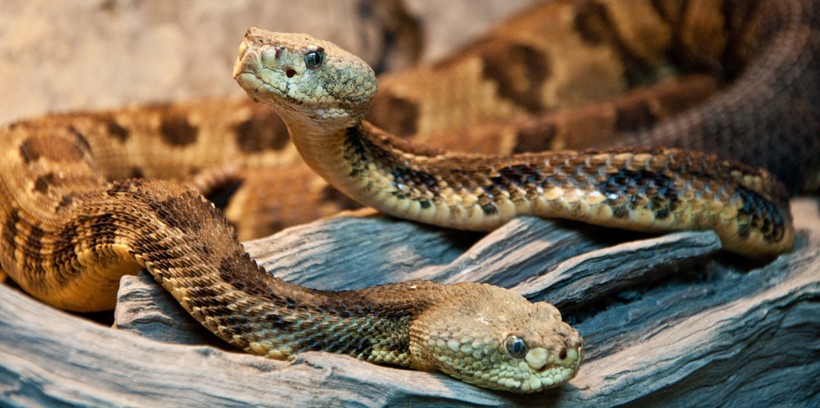
Males often follow scent trails of the female
?
Image credits: Jay Ondreicka/Shutterstock
The mating season takes place mostly during the summer months, around July to October.
Females store the sperm within their bodies throughout the winter season (hibernation period). The fertilization is oviparous and the formation of the egg and the yolk begins during late summer and fall.
The eggs begin ovulating in the following spring season after which the female must regulate a certain body temperature for embryo development.
For this, pregnant females bask in the sun in open woodlands known as ‘basking knolls’. Gravid females may utilize large hollow logs or sparsely forested regions for gestating young.
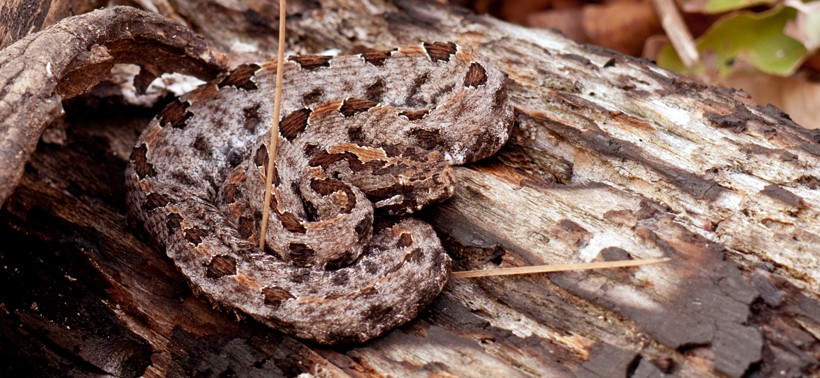
Bask in the sun on a log in Ouchita National Forest of Oklahoma
?
Image credits: Marie Shearin Images/Shutterstock
The female gives birth to a lively litter of 6 – 10 baby Timber rattlers in the autumn season (Aug – Oct). The litter size depends mostly on the female’s nutrition and overall body size.
Baby rattlers measure about 19.5 – 38 cm (0.6 – 1.2 ft) in length with an average weight of 11.2 – 30 g. Baby rattlers or juveniles hardly travel far away from their dens covering approximately 5 – 10 hectares in a particular activity season.
Unlike adults, juveniles feed on smaller rodents like field mice, shrews, voles etc.
Threats
Found commonly in eastern deciduous or coniferous spread, the Timber rattlesnake has a wide distribution. Its habitat, however, faces severe desertification.
A female Timber can reproduce only three to four times in a lifetime. Habitat destruction due to industrialization has caused a severe loss of birthing dens thereby disrupting reproductive cycles for many female Timber rattlesnakes.
Since they are ‘sit-and-wait’ predators in the wild, research has found that decreased foliage exposes the predator in the open. This reduces the Timber’s ability to camouflage itself in the wild due to which foraging becomes difficult and the snake is unable to store residual fat.
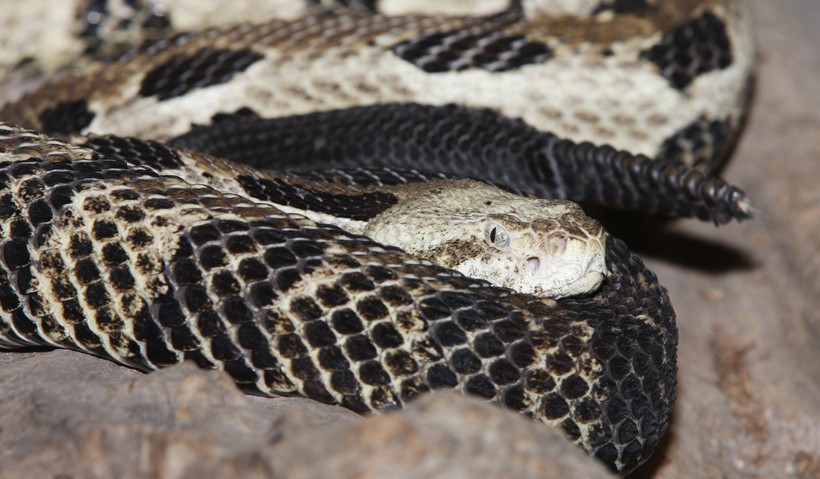
Since the timber rattlesnake is a 'sit-and-wait' predator, habitat destruction is a serious problem
?
Image credits: Michael Lynch/Shutterstock
Low reproductive output has made the Timber rattlesnake’s population vulnerable to human activities. They have become quite susceptible to man-made operations, the population being dispersed across the landscape. Road kills have therefore become a troublesome cause for the degradation of this venomous pit viper species.
Collecting or illegal trade of the Timber rattlesnake has always been a threat but deliberate killing is an increased concern. This is particularly dominant in the Midwest where the species (due to habitat destruction) becomes exposed to agricultural patches coming in direct contact with humans.
Conservation Status
According to the IUCN Red List, this species i.e. the Timber rattlesnake isn’t listed as threatened or endangered though efforts are being made to preserve the species in their natural habitats. In parts of the United States like New Jersey, the timber rattlesnakes are listed endangered and receive legal protection by wildlife authorities.
The species isn’t federally listed as Threatened or Endangered however it is recognized as one of the few pit viper species that is facing population degradation. Therefore in many Midwestern states like Indiana and Ohio, the species is considered Endangered.
Minnesota and Illinois have also registered the Timber rattlesnake as a Threatened species. On the contrary, the Timber rattlesnake receive no protection in Missouri.
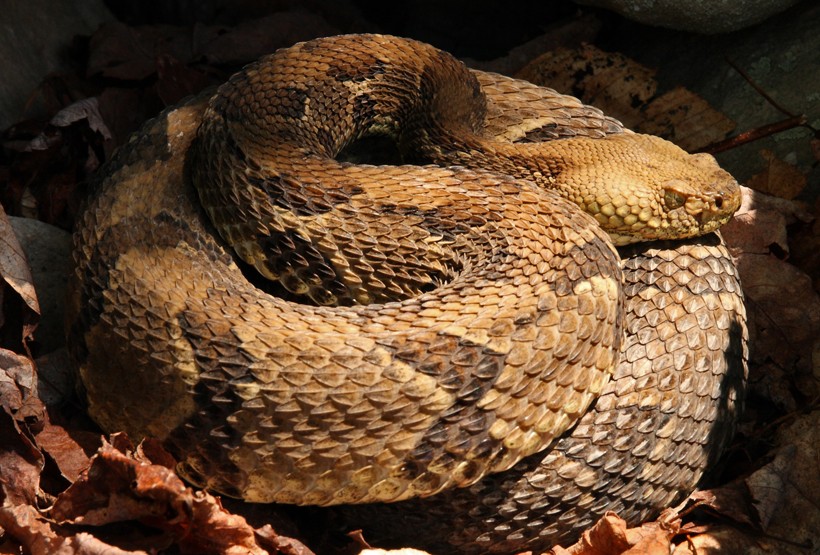
Timber rattlesnake hibernate in a den
?
Image credits: Ryan M. Bolton/Shutterstock
Wisconsin is another state where the species has been classified as ‘non-listed’ Protected Wild Animals. In New York, Texas and Connecticut, the species has been listed as Threatened receiving a certain amount of protection in these regions and the Appalachian Mountains as well. For example in Indiana, pregnant females often utilize trail edges for basking. Therefore, illegal felling of trees and extensive use of brush hogs to clear trail sites has been restricted.
Funfacts
- Michigan is the only state in the Midwest that doesn’t consist the Timber rattlesnake.
- The Timber rattlesnake has been listed as the state animal in West Virginia.
- Male and female timbers use the same den each year for consummating their union.
- The area used by male Timber rattlesnakes is larger during breeding season than females (200 hectares).
- When there is a scarcity of rocky dens, Timbers may often utilize eroded stream banks for example in the Pine Barrens of New Jersey.
- Female Timber rattlesnakes reproduce on a triennial cycle.
- Due to communal hibernation, Timber rattlesnakes are often confused with copperheads or the Eastern hog-nosed snake.
- When threatened, the Timber rattlesnake condenses its body, coiling rapidly at an angle that defines a clear strike.
- A distinguishing feature of a true rattlesnake is the upright position of the rattle that always points perpendicular to the ground.
